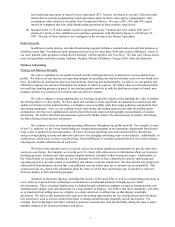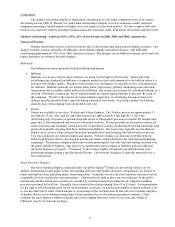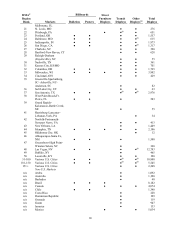iHeartMedia 2006 Annual Report Download - page 16
Download and view the complete annual report
Please find page 16 of the 2006 iHeartMedia annual report below. You can navigate through the pages in the report by either clicking on the pages listed below, or by using the keyword search tool below to find specific information within the annual report.16
prohibit an individual or entity from having an attributable interest in a radio or television station and a daily newspaper
located in the same market.
Prior to August 1999, FCC rules also generally prohibited common ownership of a television station and one or
more radio stations in the same market, although the FCC in many cases allowed such combinations under waivers of
the rule. In August 1999, however, the FCC comprehensively revised its radio/television cross-ownership rule. The
revised rule permits the common ownership of one television and up to seven same-market radio stations, or up to two
television and six same-market radio stations, if the market will have at least twenty separately owned broadcast,
newspaper and cable “voices” after the combination. Common ownership of up to two television and four radio stations
is permissible when at least ten “voices” will remain, and common ownership of up to two television stations and one
radio station is permissible in all markets regardless of voice count. The radio/television limits, moreover, are subject to
the compliance of the television and radio components of the combination with the television duopoly rule and the local
radio ownership limits, respectively. Waivers of the radio/television cross-ownership rule are available only where the
station being acquired is “failed” (i.e., off the air for at least four months or involved in court-supervised involuntary
bankruptcy or insolvency proceedings). A buyer seeking such a waiver must also demonstrate, in most cases, that it is
the only buyer ready, willing, and able to operate the station, and that sale to an out-of-market buyer would result in an
artificially depressed price.
There are more than 20 markets where we own both radio and television stations. In the majority of these
markets, the number of radio stations we own complies with the limit imposed by the current rule. Our acquisition of
television stations in five markets in our 2002 merger with The Ackerley Group resulted in our owning more radio
stations in these markets than is permitted by the current rule. The FCC has given us a temporary period of time to come
into compliance with the rule. We have come into compliance with respect to two such markets and have requested an
extension of time to come into compliance with respect to the other three markets. In the remaining markets where our
number of radio stations exceeds the limit under the current rule, we are nonetheless authorized to retain our present
television/radio combinations at least until the FCC’s next periodic ownership rule review. As with grandfathered
television LMAs, we may seek permanent authorization for our non-compliant radio/television combinations by
demonstrating to the FCC, among other things, the public interest benefits the combinations have produced and the
extent to which the combinations have enabled the television stations involved to convert to digital operation.
Under the FCC’s ownership rules, an officer or director of our company or a direct or indirect purchaser of
certain types of our securities could cause us to violate FCC regulations or policies if that purchaser owned or acquired
an “attributable” interest in other media properties in the same areas as our stations or in a manner otherwise prohibited
by the FCC. All officers and directors of a licensee and any direct or indirect parent, general partners, limited partners
and limited liability company members who are not properly “insulated” from management activities, and stockholders
who own five percent or more of the outstanding voting stock of a licensee or its parent, either directly or indirectly,
generally will be deemed to have an attributable interest in the licensee. Certain institutional investors who exert no
control or influence over a licensee may own up to twenty percent of a licensee’s or its parent’s outstanding voting stock
before attribution occurs. Under current FCC regulations, debt instruments, non-voting stock, minority voting stock
interests in corporations having a single majority shareholder, and properly insulated limited partnership and limited
liability company interests as to which the licensee certifies that the interest holders are not “materially involved” in the
management and operation of the subject media property generally are not subject to attribution unless such interests
implicate the FCC’s “equity/debt plus,” or “EDP,” rule. Under the EDP rule, an aggregate debt and/or equity interest in
excess of 33% of a licensee’s total asset value (equity plus debt) is attributable if the interest holder is either a major
program supplier (providing over 15% of the licensee’s station’s total weekly broadcast programming hours) or a same-
market media owner (including broadcasters, cable operators, and newspapers). To the best of our knowledge at present,
none of our officers, directors or five percent or greater stockholders holds an interest in another television station, radio
station, cable television system or daily newspaper that is inconsistent with the FCC’s ownership rules and policies.
Developments and Future Actions Regarding Multiple Ownership Rules
Expansion of our broadcast operations in particular areas and nationwide will continue to be subject to the
FCC’s ownership rules and any further changes the FCC or Congress may adopt. Recent actions by and pending
proceedings before the FCC, Congress and the courts may significantly affect our business.
The 1996 Act requires the FCC to review its remaining ownership rules biennially as part of its regulatory
reform obligations (although, under subsequently enacted appropriations legislation, the FCC is obligated to review the
rules every four years rather than biennially). The first two biennial reviews did not result in any significant changes to
the FCC’s media ownership rules, although the first such review led to the commencement of several separate
proceedings concerning specific rules.
























